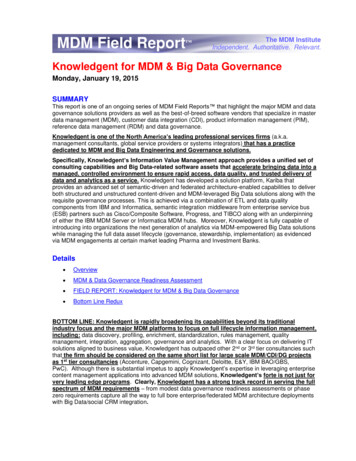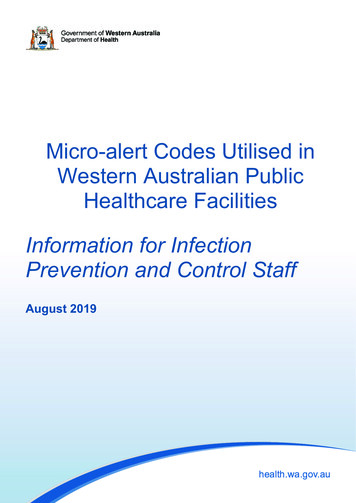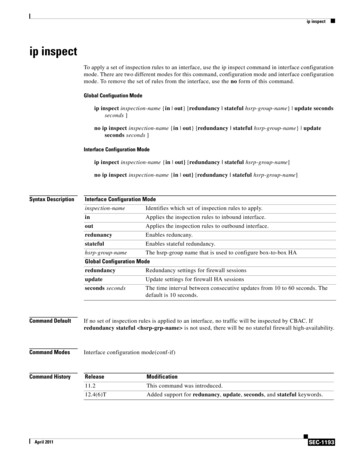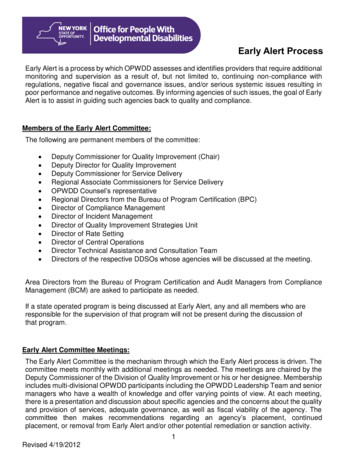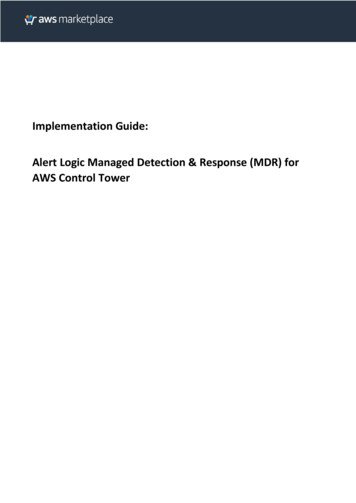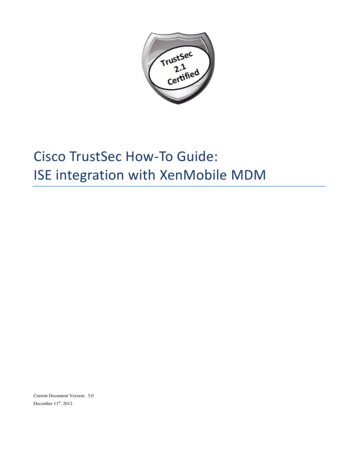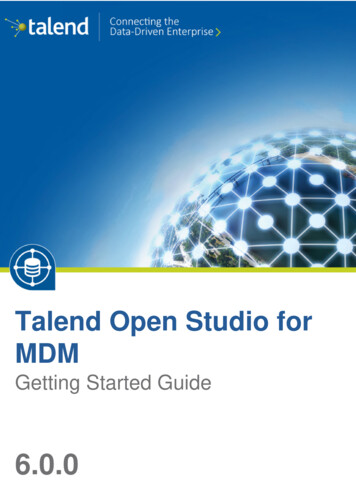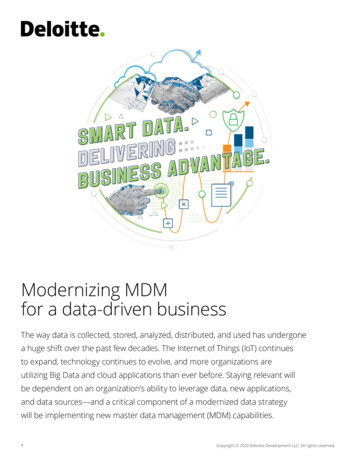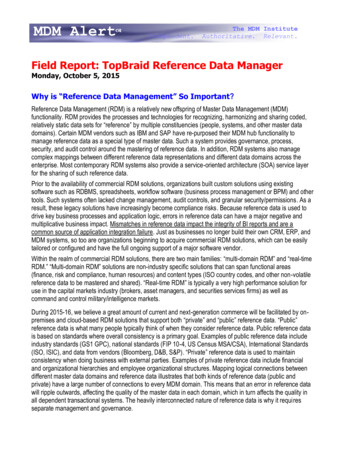
Transcription
MDM Alert Independent.The MDM InstituteAuthoritative. Relevant.Field Report: TopBraid Reference Data ManagerMonday, October 5, 2015Why is “Reference Data Management” So Important?Reference Data Management (RDM) is a relatively new offspring of Master Data Management (MDM)functionality. RDM provides the processes and technologies for recognizing, harmonizing and sharing coded,relatively static data sets for “reference” by multiple constituencies (people, systems, and other master datadomains). Certain MDM vendors such as IBM and SAP have re-purposed their MDM hub functionality tomanage reference data as a special type of master data. Such a system provides governance, process,security, and audit control around the mastering of reference data. In addition, RDM systems also managecomplex mappings between different reference data representations and different data domains across theenterprise. Most contemporary RDM systems also provide a service-oriented architecture (SOA) service layerfor the sharing of such reference data.Prior to the availability of commercial RDM solutions, organizations built custom solutions using existingsoftware such as RDBMS, spreadsheets, workflow software (business process management or BPM) and othertools. Such systems often lacked change management, audit controls, and granular security/permissions. As aresult, these legacy solutions have increasingly become compliance risks. Because reference data is used todrive key business processes and application logic, errors in reference data can have a major negative andmultiplicative business impact. Mismatches in reference data impact the integrity of BI reports and are acommon source of application integration failure. Just as businesses no longer build their own CRM, ERP, andMDM systems, so too are organizations beginning to acquire commercial RDM solutions, which can be easilytailored or configured and have the full ongoing support of a major software vendor.Within the realm of commercial RDM solutions, there are two main families: “multi-domain RDM” and “real-timeRDM.” “Multi-domain RDM” solutions are non-industry specific solutions that can span functional areas(finance, risk and compliance, human resources) and content types (ISO country codes, and other non-volatilereference data to be mastered and shared). “Real-time RDM” is typically a very high performance solution foruse in the capital markets industry (brokers, asset managers, and securities services firms) as well ascommand and control military/intelligence markets.During 2015-16, we believe a great amount of current and next-generation commerce will be facilitated by onpremises and cloud-based RDM solutions that support both “private” and “public” reference data. “Public”reference data is what many people typically think of when they consider reference data. Public reference datais based on standards where overall consistency is a primary goal. Examples of public reference data includeindustry standards (GS1 GPC), national standards (FIP 10-4, US Census MSA/CSA), International Standards(ISO, ISIC), and data from vendors (Bloomberg, D&B, S&P). “Private” reference data is used to maintainconsistency when doing business with external parties. Examples of private reference data include financialand organizational hierarchies and employee organizational structures. Mapping logical connections betweendifferent master data domains and reference data illustrates that both kinds of reference data (public andprivate) have a large number of connections to every MDM domain. This means that an error in reference datawill ripple outwards, affecting the quality of the master data in each domain, which in turn affects the quality inall dependent transactional systems. The heavily interconnected nature of reference data is why it requiresseparate management and governance.
Clearly, Reference Data Management is a major IT initiative being undertaken by a large number ofmarket-leading global 5000 enterprises. Both as an IT discipline and a commercial off-the-shelf softwaresolution, RDM solutions are being brought to market at an increasing pace. Additionally, RDM is a good entrylevel project to show success for initial MDM investment which can be built on as a data governance model.BOTTOM LINE: TopQuadrant’s TopBraid RDM solution is a new entrant into the reference datamarketplace. It is a self-service reference data governance hub for subject matter experts that provides“full spectrum” reference data to comprehensively support an enterprise’s IT portfolio. Due to its agilestyle approach to business data modelling, TopBraid RDM appears to be an excellent choice as aflexible and low cost (yet fast time to value) web-based solution for reference data governance.Additionally, its strong semantic querying features (based on open standards), taxonomy support, andmappings/crosswalks promote business user and data steward self-service that requires only modestinitial IT support. Moreover, TopBraid RDM is a purpose-built reference data management solutionrather than providing capabilities derived from an operational or consolidation MDM hub. During 201516, organizations evaluating reference data solutions where user-directed, agile governance ofreference data is the key use case should consider the TopBraid RDM solution – independent of otherMDM investments.The “Field Report” Methodology2015-16 “MDM & Data Governance Road Map.” Part of the deliverables for our client Advisory Council is anannual set of milestones to serve as a “road map” to help Global 5000 enterprises focus efforts for their ownMDM programs. For planning purposes, we thus annually identify ten milestones that we then explore, refineand publish via our MDM Alert research newsletter. This set of “strategic planning assumptions” presents anexperience-based view of the key trends and issues facing IT organizations by highlighting: MDM, DataGovernance, Customer Data Integration (CDI), Product Information Management (PIM), and Reference DataManagement (RDM).Thus the 2015-16 MDM road map helps Global 5000 enterprises (and IT vendors selling into this space) utilizethese “strategic planning assumptions” to help focus their own road maps on large-scale and mission-criticalMDM projects. During the following year, we use these milestones as the focus for our analyst research in thatevery research report we write either confirms or evolves one or more milestones as its premise:1.2.3.4.5.Pervasive MDMData governanceBusiness process hubsUniversal MDMReference data6.7.8.9.10.Social MDMIdentity resolutionBig dataBusiness-critical MDMBudgets/skillsAs an industry-funded multi-client study, the MDM Institute is releasing its “Reference Data Management:Market Review & Forecast for 2015-16” during 1H2016. Among other benefits, this industry report providesinsights into: what is RDM, what are the business drivers for RDM, what are the major use cases, what are thetechnical challenges, who are the major solution providers (software vendors and consultancies), how toevaluate such solutions, and what are the best practices for RDM in the large enterprise. Additionally, the MDMInstitute is providing a series of Field Reports that will provide details on the merits and caveats of the variouslymarketed commercial multi-domain RDM solutions.The majority of this Field Report on TopBraid RDM’s capabilities therefore represents our analystopinion buttressed by in-depth reviews, evaluations and (often) hands-on proofs-of-concept executedby the membership of the MDM Institute's Advisory Council. 2015 The MDM Institute.Page 2
Evolution of TopQuadrant’s Reference Data Management SolutionTopQuadrant is an Enterprise Information Management (EIM) company that helps organizations govern itsinformation irrespective of its structure, origin or location. TopQuadrant was founded in 2001 as the firstsemantic web consulting company in the US. Working with its first customers, The TopQuadrant teamdiscovered that semantic web standards are especially well suited to providing integrated, next-generationinformation management and data governance solutions. This realization led to TopQuadrant developing itsfirst product in 2006. TopQuadrant’s products are marketed under the brand TopBraid and support referencedata governance, business glossaries, metadata management, taxonomy and ontology management. Today,the product family consists of: TopBraid Reference Data Manager supports the governance and provisioning of enterprise referencedata, including metadata management and a business glossaries module. TopBraid Enterprise Vocabulary Net supports search enrichment, content navigation and integration ofunstructured data though the use of governed controlled vocabularies, including a content taggingmodule. TopBraid Insight is a virtual data warehouse that enables federated querying of data across diversedata sources as if they were in one place. TopBraid Live is a semantic applications server that is the foundation for each of TopQuadrant’sproducts. TopBraid Live has also been used directly by customers and OEM-ed by other vendors tobuild custom business solutions not supported in the above products. TopBraid Composer is an Integrated Development Environment (IDE) and a modeling tool used toextend and customize TopQuadrant’s solutions.TopQuadrant’s founders, Irene Polikoff, Ralph Hodgson and Robert Coyne met while working at IBM. Theexecutive team has deep experience in information technology with over 60 years of combined experience inmanaging technology from concept to revenue. This team has a historical strong commitment to standardsbased approaches to data semantics, with the mission of making enterprise information meaningful. 2015 The MDM Institute.Page 3
Summary Evaluation - Top 10 Evaluation Criteria As part of the interactions with its Customer Advisory Council, the MDM Institute captures and promotesmodels such as “top 10 evaluation criteria” for key MDM-related technologies and areas of interest. During1H2015 and as part of the background research forthe much more comprehensive “Reference DataFigure 1 - Overview of TopBraid RDMManagement: Market Review & Forecast forSTRENGTHS2015-16” report, more than thirty Global 5000 size1. Robust web-based self-service solution asenterprises shared their software evaluationpurpose-built RDM with focus on integrationprocesses and also contributed commentary andwith other tools to provide ‘full spectrum’supporting details for a set of “top 10” evaluationreference data in any form & delivery channelcriteria for RDM solutions. These evaluation criteria2. Model-driven ease of deployment, use &(Figure 1) are discussed in more detail in the aboveextensionreferenced market study. The majority of this Field3. Supports comprehensive “metadata aboutReport in turn takes these “top 10” evaluation criteriareference data” plus strong taxonomyas a framework to discuss and understand thesupport & mappings/crosswalkscapabilities of TopBraid RDM as an RDM Hub.1. Ability to Map Reference Data — An RDMhub must be able to manage application-specific orlocal adaptations of a reference data set (e.g.,foreign language versions or additional fields.) alongwith canonical data sets. In addition, relationshipsbetween reference data sets should also bemanaged. With TopBraid RDM, flexible referencetables support both private (e.g., financedepartment) and public reference data (e.g.,syndicated data such as DUNS and ISO and otherstandard reference data sets).4. Business model & semantic querying featuresbased on open standards15. RACI-based governance & security withconfigurable, fine-grained notifications6. On-premise & Cloud-enabled2CAVEATS1. Curated data sets not currently supplied(planned release, YE2015)2. Just beginning to explicitly market RDMcapabilities33. Underinvested in marketingTopBraid can accommodate most any reference1 Widely-used, W3C (RDF, SPARQL) semantic-standardsdata that the customer wants to draw into the modelbased platformvia its business user interface. TopBraid RDM2 Apache Docker AMZN AWS, Azure, et al; SaaS availablesupports 1:1, 1:many and many:many mappingsthrough Amazon Marketplacebetween reference data value sets, and comments3 Non-RDM customers using TopBraid for business glossariescan be included on each individual mapping. Since& other aspects of metadata management include: Bank ofRDM captures usage information, services canAmerica, J&J, JP Morgan Chase, Mayo Clinic, NASA, OECC,OTPP, Lilly, ServiceNow, Syngenta, Thomson Reuters, USAFtranslate between a code used by one system andother Fortune 1000 companies across different industriesthe alternative used by another system. Taxonomies andincluding life sciences, financial services, oil/gas, digitaland associations can be easily modeled to constructmedia, manufacturing & energy industriesreference taxonomies (e.g., industry classifications,Source: The MDM Instituteproduct categories, market segments) and referencedata maps (e.g., crosswalk ICD-9 code sets withICD-10 code sets). Furthermore, as changes are made to an application-specific reference data set, the datasteward (subject matter expert or SME) can easily identify those changes and determine whether they requirenew entries to be created. Changes may also be shepherded with tailored workflows to curate code changes orenable a collaborative sequence of activities and tasks to keep reference data sets accurate and relevant. 2015 The MDM Institute.Page 4
2. Administration of Reference Data Types — One of the common problems with homegrown reference datasolutions is that a single data model cannot easily represent the many different types of reference data requiredfor the enterprise. The data model needs to be extended to support new reference data sets and newproperties specific to the varied types of reference data being managed. Because most MDM solutions use arelational DBMS approach, model changes require development work and IT intervention to enhance therepository, screens, and interfaces. This further reinforces the need for semantic or object-oriented modelingand implementation of reference data. TopQuadrant’s RDM utilizes W3C semantic standards-basedrepresentation and models for everything in the product, including the data sets, metadata about the referencedata, permissions and data quality rules. This provides more flexibility and interoperability than even proprietaryobject modeling approaches, and the data store is a standards-based NoSQL graph database convenientlypersisted using any traditional SQL database. With this platform, TopBraid RDM is able to provide anorganization total flexibility in defining diverse reference data types. With absolutely no coding nor involvementof administrators, any authorized user can define a new type of data and associated attributes andrelationships. They can also manage information not only about reference data but also about the referencedata sets themselves, such as who provides governance, what the onboarding procedures are, and where it isused.3. Management of Reference Data Sets — TopBraid RDM takes a consensus-driven approach to designinginteractions between data stewards and front-line business users. Specifically, its data governance andmanagement capabilities provide stewards or reference data owners the power to tailor the curation,enrichment and approval of reference data on-boarding, changes and distribution. Change management andgovernance capabilities include: flexible RACI-based notifications, versioning, and “working copies” as virtualsnapshots for review and approval before committing to production. The working copy mechanism is also usedfor verification of compliance of enterprise systems to the approved reference data. These capabilities canenable collaborative co-creation between cross-functional stakeholders across the front-office, back-office andperformance management office to deliver reference data sets that ensure business agility and promotetrustworthy insights. By providing intuitive UIs and a flexible data model to reference datastewards/SMEs/authors as well as information contributors and consumers, an enterprise can quickly install,configure and manage reference data with minimal ongoing IT involvement. With the business user as thedesign point, all of the UIs and stewardship processes are thus defined for RDM explicitly. This is in contrast toMDM solutions retrofitted to serve as RDM solutions. Such alternative RDM-via-custom-domain solutionstypically entail more initial implementation work than a purpose-built/native RDM solution. In addition, the“custom build” approach usually requires additional development effort on an ongoing basis. Comparativelyspeaking, many other RDM solutions do *not* leverage the semantic/object data model but instead take aSwiss Army knife approach to RDM in that each RDM object type is implemented as a separate MDM domain.4. Architecture/Performance — TopBraid RDM takes a configuration-based, model-driven approach tomastering any business entity. This requires absolutely no coding on part of an implementing organization. Withthe combination of a fully extensible logical data model coupled with a variety of application templates asmodeling accelerators, TopBraid RDM provides extreme time-to-value and low maintenance (minimal ITinvolvement). The product also takes an in-memory approach to managing value sets. End users select aversion of information, all of which is brought into memory to facilitate high performance automated attributemaintenance, and to compare alternate business perspectives of historical, forward-looking and productionviews into fully reconciled master reference information assets. TopBraid RDM leverages 64-bit architectures(H/W, OS) to deliver unlimited memory addressability as well as higher levels of concurrency to scale dataprocessing as well as concurrent users. TopBraid RDM uses a standards-based NoSQL graph database as itsrepository on top of traditional RDBMS systems such as Oracle, MySQL and Microsoft SQL Server. With this,enterprises can take advantage of the graph database flexibility while enjoying the transactional support andmature backup and recovery capabilities of relational databases. 2015 The MDM Institute.Page 5
5. Hierarchy Management over Sets of Reference Data — Reference code tables can be either flat lists orhave hierarchies. The hierarchical structure is a key aspect of reference data that needs to be managed inaddition to the values and mapping relationships. With TopBraid RDM, a hierarchy can be defined over valueswithin a code table, or a hierarchy can be defined where each level is a code table in its own right. And, anyrelationship can be used to view and export data as a hierarchy. While the meaning of reference data elementshas low rates of change, the relationships, or hierarchies, defined by reference data change more frequently asa business realigns its reporting structures and systems to match changing business requirements. A simpleexample is how a company may have several definitions of what is included in North America with analternative reference data set where the Legal department view may include Mexico in North America, yet aSales and Marketing view may consider Mexico as part of a Latin American grouping. This need to customize,or adapt, reference data hierarchies and definitions manifests itself across all kinds of reference data —especially private reference data from the finance department or domain. For Finance, there are often threemain adaptations: tax, regulatory reporting, and managerial. However, “privatized” reference data can causeproblems if it loses its association with its original source. This is because sources continue to evolve(especially true for industry standards) and without lifecycle management and ties back to its “public”antecedent, the “privatized” set can quickly get out of sync, reducing the benefit of implementing a standard.This requires that the platform support adaptations while maintaining links to the original data set.TopBraid RDM provides support for cross-walking both “public” and “private” reference data sets. Commonscenarios include mapping: (a) DUNS hierarchies to internal private corporate hierarchies; (b) enterprise riskmanagement hierarchies (to manage credit risk, BASEL II/III, BCBS 239 compliance); (c) Salesforce.comorganization structures to each other as well as downstream ERP applications; and (d) industry-specificreference data sets for the entertainment, media and publishing verticals. TopBraid RDM addresses bothhierarchies and adaptations of master data. Unlike many other RDM platforms, TopBraid RDM is able tomanage complex product hierarches (e.g., CPG and Financial Services) and classification sets (i.e., what levelthat hierarchy points to in other sets). Via multi-level and even unbalanced hierarchies, RDM can be put to workto model business relationships without limitations.6. Connectivity — It is vital that an RDM solution provide multiple, flexible means of connectivity to providemaximum “accessibility.” Reference data must be made easily available to downstream application systems,remote subscribers, etc. Furthermore, consumers of RDM data must be able to access the data in a means andformat that is most convenient to them. Therefore, RDM solutions must be able to expose the reference data inmultiple, flexible diverse ways such as: (a) on-demand access using SOAP or REST web services, (b) ondemand access or scheduled publication to flat and XML files, and (c) direct connections to remote databases.Each RDM channel must allow for retrieving either all data sets or lookups of specific entries. TopBraid RDMsupports these three connectivity styles in an agile way; for instance, it enables end-users to easily and quicklycreate web services for distribution of reference data – without programming.7. Import and Export — The TopBraid RDM solution provides import and export of reference data in multipleformats—for example, for inbound and outbound mappings from/to data definitions, sources and destinationssuch as flat files, file servers or databases, as well as CSV, JSON, and XML formats. Wizards guide the userthrough the process of mapping the import columns to the reference data set properties within the hub. Thesemappings are saved and can be re-used in subsequent imports of data with the same structure. Power usersmay also use a simple scripting mechanism to develop import scripts to handle more complex datatransformations which can include callouts to external web services and sources. Data can also be importedand exported using APIs provided in the product as web services. The verification of enterprise systemconformance with reference data sets managed by TopBraid RDM is also supported through the product’simport capabilities. For example, a common use is for a web service to import the data used by an applicationwhich can then be compared with the respective RDM-governed reference data set. 2015 The MDM Institute.Page 6
8. Versioning Support — The notion of “time travel” or “temporal RDM” relates to the ability to traverseforward or backwards in time (“effective dates,” etc.) in support of recreating reference data tables and thehierarchies that manage the reference data relationships. TopBraid RDM supports versioning of reference datasets and related mappings. Such versioning is used in conjunction with lifecycle management to managechanges to the reference data sets and mappings over time. This versioning support manages the lifecycle of acanonical set, the lifecycle of application-specific or local sets mapped to the canonical, and the lifecycle of themappings themselves. It also supports the notion of “temporal” reference data across hierarchies andrelationships. As an example, an analytical system needs access to current and prior historical versions ofreference data in order to support trending and comparison reporting. Without consistent definitions (ortranslations), business analytics will be like “comparing apples to oranges.” Access to future dated referencedata versions (e.g., “effective date” or “as of” dating for mergers or sales territory reorganizations) can be usefulfor impact analysis modeling. In addition, TopBraid RDM supports “cross-temporal” relationships/mappings thatexist between different versions of the same reference data. This is commonly seen in classification standardssuch as North American Industrial Classification System (NAICS) or International Classification of Diseases(ICD). Codes in prior editions may have many-to-one, or one-to-many relationships with later editions. Forexample, in NAICS 2007 two codes exist for soy bean and oil seed processing. These codes were consolidatedinto one code for the 2012 version of NAICS. Therefore the single code in NAICS 2012 has a one-to-manyrelationship with codes in NAICS 2007. TopBraid RDM also provides modeling of business rules andconstraints (on values and relationships) to maintain referential integrity between master data domains as wellas versions (past, present and future).9. Security and Access Control — TopBraid RDM provides robust and secure data sharing via role-basedaccess control and a fine grained data hierarchy-centric security model. CRUD access to a particular entity iscontrolled by the user’s role, the groups that the user is a member of, and those groups’ data access privilegesassociated with the underlying business taxonomy. The solution supports native or external authentication,single sign-on and supports external directories including LDAP and Microsoft Active Directory.10. E2E Lifecycle Management — TopBraid RDM includes an SME-intuitive data governance facility thatprovides UI and workflow processes to support formal governance of reference data, thus putting end-to-endlifecycle management of enterprise reference data in the hands of business users — reducing the burden on ITand improving the overall quality of data used across the organization. This change management process iscontrolled through a configurable facility that is used by the data stewards to control versions of reference datasets and mappings that are in use. Every reference data set and mapping has a state that corresponds to itscurrent state in the lifecycle (e.g., draft, approved, retired). The TopBraid RDM solution supports configurablestates and transitions without requiring IT development, enabling the formal governance processes to keep upwith a company's changing governance requirements. The built-in RDM governance workflows include taskmanagement to capture work items, questions and issues whereby tasks have statuses, comments anddiscussions. Additionally, TopBraid RDM supports RACI to capture accountability and responsibility, and thesegovernance assignments can be informed through the lifecycle with configurable, fine-grained notifications ofchanges and other events at the data set and individual code level. Competitive OutlookCompetition for an RDM product such as the TopBraid Reference Data Manager solution includes: Custom-built, manual solutions Hierarchy management system adaptations Custom MDM domain type Multi-domain RDM Purpose-Built or Industry-Specific RDM 2015 The MDM Institute.Page 7
Custom-Built, Manual Solutions — Many enterprises struggle with home-grown RDM using spreadsheetsand other error-prone manual processes to manage reference data sets and their relationships to each other.Just as customer-built CRM, ERP and MDM have faded when commercial off-the-shelf solutions becamewidely available, so too will manual RDM solutions fall into disfavor. With custom-built or home-grown RDMsolutions, stewards have to rely on IT for changes to functionality and are unable to change the business rulesrelating to the reference data themselves. Commercial RDM software platforms often struggle to get theattention of large, well-known consulting firms for two reasons: (1) these consultancies would rather sell clientsa custom RDM solution and (2) they would rather implement more complex RDM modules that increaseimplementation cycles and grow billing potential. Hierarchy Management System Adaptations — Organizations can attempt to use simple hierarchymanagement software, but such systems do not readily support publish-subscribe, classification mapping, etc.(e.g., Microsoft Master Data Services (MDS)). Many finance departments use tools such as Microsoft MDS forfinancial hierarchies and attempt to apply these tools to hierarchies in human resource assets, location assets,etc. To provide rudimentary RDM-like capabilities, any organization that utilizes Microsoft MDS will also need tointroduce another 3rd party RDM bolt-on such as Profisee, Riversand or VisionWare. This approach has notproven enterprise-scalable in our experience and introduces multi-vendor complexities. TopBraid RDM hasgood support for hierarchical reference data sets; it supports these types of relationships to any depth ofhierarchy. Custom MDM Domain Type — Both Informatica (Informatica MDM) and SAP (SAP Master Data GovernanceCUSTOM object) offer the capability for custom domains to be created and managed in order to implementreference data management. Reports from organizations that have gone this route indicate that it is not as easyto implement RDM as a custom domain type as these vendors promote. In multi-domain MDM solutionsoriginally designed for managing customer data (e.g. IBM MDM Server and Informatica MDM), organizationsreport lack of data modeling flexibility, rudimentary lifecycle management capabilities and limited datagovernance features, in particular around authoring, workflow and cross-temporal relationship management.TopBraid RDM supports considerable modeling flexibility to enable custom MDM domain types via the ability touse such domains for RDM and other master data.Multi-Domain RDM — Certain of the commerciall
MDM investments. The "Field Report" Methodology 2015-16 "MDM & Data Governance Road Map." Part of the deliverables for our client Advisory Council is an annual set of milestones to serve as a "road map" to help Global 5000 enterprises focus efforts for their own MDM programs.


